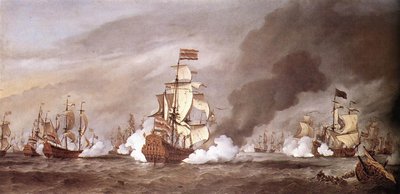Battle of Texel
|
|
For the 1653 battle near Texel, see the Battle of Scheveningen

The naval Battle of Texel took place between the Dutch and the combined English and French fleets on 11 August 1673 (New Style), and was the last major battle of the Third Anglo-Dutch War, which was itself part of the Franco-Dutch War (1672–1678), during which Louis XIV of France sought to establish control over the Spanish Netherlands and invaded the Republic. The English involvement came about because of treaty obligations (the secret Treaty of Dover) and was highly unpopular.
The overall commanders of the English and Dutch military forces were High Lord Admiral James, Duke of York, afterwards King James II of England, and Admiral-General William III of Orange, James' son-in-law and also a future King of England. Neither of them took part in the fight. The Battle of Texel was joined when a Dutch fleet sought to oppose the landing of troops by a combined Anglo-French fleet.
Prince Rupert of the Rhine commanded the Allied fleet of about 92 ships and 30 fireships, taking control of the centre himself, with D'Estrées commanding the van, and Sir Edward Spragge the rear division. The Dutch fleet of 75 ships and 30 fireships was commanded by Lieutenant-Admiral-General Michiel de Ruyter, with Lieutenant-Admirals Adriaen Banckert in charge of the van and Cornelis Tromp the rear.
De Ruyter first decided not to leave his defensive position in the Schooneveld, from which he had succesfully engaged the allied fleet in the double Battle of Schooneveld, but was ordered to do so by stadtholder William in order to save the Spice Fleet returning from the Indies.
Although outnumbered, De Ruyter gained the weather gauge and sent his van under Banckert in to separate the Allied van (under D'Estrées) from the main fleet. His ploy was effective, and the French ships were unable to play a significant part in the remainder of the battle, which became a gruelling encounter between the bulk of the Dutch fleet and the English centre and rear divisions. Both suffered badly during hours of fierce fighting.
Spragge and Tromp, commanding their respective rear divisions, clashed repeatedy - Spragge had publicly sworn an oath that this time he would either kill or capture his old enemy Tromp - each having their ships so damaged as to need to shift their flags to fresh ships three times. On third occasion, Spragge drowned when his boat took a shot and sank. The fight then focused on an attempt by the Dutch to capture Spragge's abandoned flag ship, the Royal Prince, which in the end failed.
With both fleets exhausted, the English eventually abandoned their attempt to land troops (the landing force was still waiting in England to be shipped), and both sides retired. No ship was sunk, but many were seriously damaged and about 3,000 men died: two-thirds of them English or French. After the battle Prince Rupert complained that the French had not done their share of the fighting, but historians ascribe the lack of French impact on the battle to de Ruyter's brilliant fleet handling. It's true however that Count d'Estrées had strict orders from Louis XIV not to endanger the French fleet, as he himself admitted after the battle. Despite its inconclusive finish, the battle was a clear strategic victory for the Dutch.
In the months following, the Netherlands formed an alliance with Spain and the French withdrew from the territory of the Republic. The Third Anglo-Dutch War came to an end with the signing of the Treaty of Westminster between the English and the Dutch in 1674. Only in 1781 would the Dutch and British fleets fight each other again.nl:Slag bij Texel
